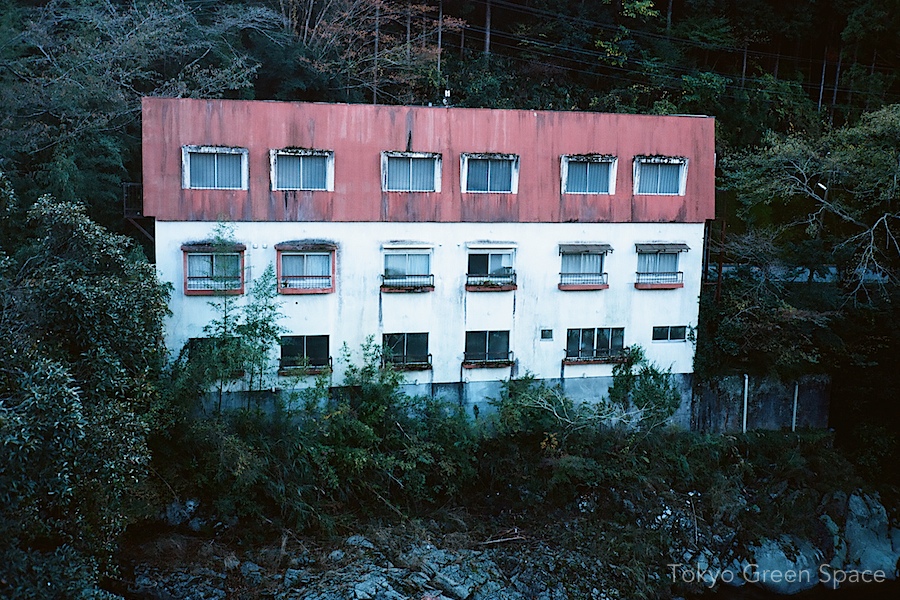
日本の田舎に、人なしの建物が多いでしょう。不思議。
Eery to see so many abandoned buildings in the Japanese countryside.

廃墟になった家のまわりに、だれにも世話をされていない庭がどんどん大きくなっています。アジサイはかなり背が高いと思いませんか? 東京では、一年中雨が降ります。
This is one of the tallest hydrangeas I have ever seen. It’s growing outside this once handsome house near where we live. Tokyo’s ample year-round rain make it easy for plants to survive without our help. I’m hoping they won’t tear down the place soon, because this wild garden only requires being left alone.

東京に、使われていないところはすぐにコインパーキングになります。この中野の空き地は、成長した木やアートや雑草でにぎやかです。
Most unused land in Tokyo quickly becomes automated coin parking for automobiles. I like this empty lot with a mature tree, art work, and amazing collection of weeds.
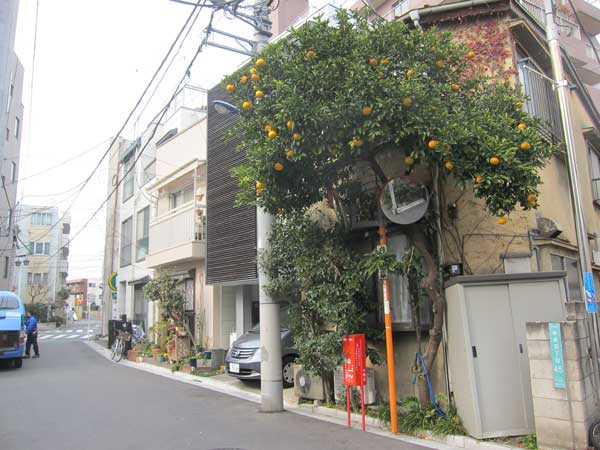
東京に来たとき、柑橘類の木を見て驚きました。冬に果物が熟成しますが、寒すぎるのではないかと思いました。最初、このハッサクは食べれないと東京の人はみんな言いました。去年カナダ人の友だちが、閉鎖された公立学校の庭でハッサクを収穫して、商店街の人たちと一緒にマーマレードを作りました。装飾にも食用にもなります。
Freezing temperatures and icy streets are keeping me indoors. But I am always amazed at how much still grows in Tokyo’s winter months. The most spectacular and surprising is this large citrus called “hassaku.”
For years I believed general comments about how the fruit is too sour to eat. Then I participated last year in Edoble’s hassaku marmalade-making. This tree can be seen everywhere in Tokyo, so it must be well suited. I like how it’s both decorative and edible!
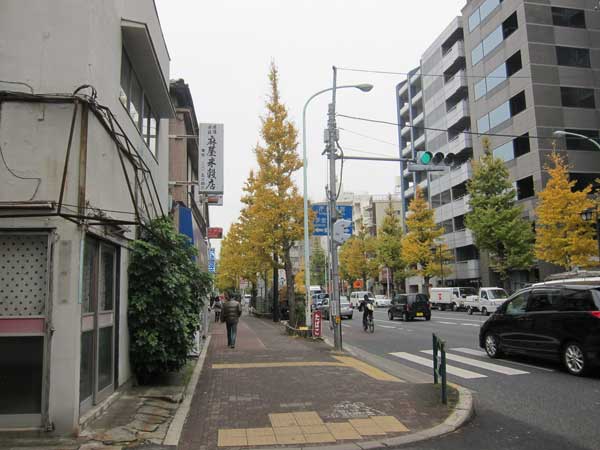
青梅街道は江戸時代からある道で、昔ここに農園がありました。今はイチョウの木がたくさんの種類の建物をつないでいます。廃墟化した戦後の建物や商業用の建物や住宅やさらには軽工業のビルがあります。
Ome Kaido is a large boulevard in my neighborhood that dates to Edo times when this area was largely fields. I like how the ginko trees provide a unifying element to a heterogenous streetscape of abandoned post-war buildings mixed with newer commercial, residential and even light industrial buildings from every decade since.
Directly across the street from this corner is a ten story office building. I noticed the roof-top sports facility years before I recognized the logo at the entrance that marks it as the headquarters of one of Japan’s leading adult content companies.
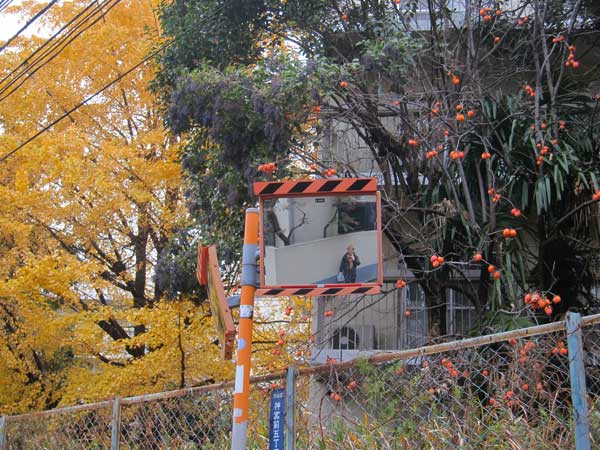
神宮前の路地を歩いているときに、廃墟の団地を発見しました。おそらくここに高級マンションが建てられます。この風景が破壊されるまでは、自然の島のようです。柿や紅葉や野生生物がいます。
Walking in the back streets in Jingumae, I came across this fantastic abandoned housing project. Soon the lot will no doubt be scraped and redeveloped into luxury residences with minimal landscaping. Until then, it’s an island of nature, full of persimmons, fall foliage, and wildlife.


Through this blog, I was contacted by Edoble, whose tag line is “free food everywhere, in Tokyo.” Last month Edoble organized a hassaku marmelade party at a small shoutengai in Nakano, not far from where I live.
Edoble’s founder Jess Mantell is a Canadian designer, doctoral student, city explorer, and community organizer. As you can see from the poster above, she’s a great illustrator, too. At Keio University, she previously led a team that created an iPhone app that tracks movement across Tokyo with city sounds.
Edoble’s hassaku marmalade making event was great fun. Hassaku is a citrus tree that I often see growing in older gardens in Tokyo. The tree is very robust, and the fruits bright orange and large starting in winter. Seeing them makes me feel like there’s a bit of Florida or Southern California in Tokyo. But everyone had told me that the fruit is inedible. Jess’ idea was to bring people together to harvest and prepare hassaku.
It seems that if you pick the fruit at different times, the taste changes. Jess spotted mature hassaku trees in an abandoned city middle school near her house in south Nakano. She asked permission from the ward office to harvest the fruit in the spring, and several city workers unlocked the gate and joined her in collecting and sharing the fruit. That alone is pretty cool.
In June, Edoble hosted a marmalade party as a public event at a small space that is shared by the shoutengai association. On June 11, about twenty people very rapidly peeled the fruit, eliminated the membrane, put the seeds and membrane into a cheese cloth, and then boiled everything in four large pots. It was fun to see the amazing knife skills, particularly the older women and one young nursery school chef. We even got some help from some neighborhood kids.
The workshop was super-inspiring. It is great to realize how much food is growing in Tokyo, and that we can join with our neighbors in collecting and preparing super local food. Edoble’s accomplishment was in bringing together residents and local government, children and seniors, mostly Japanese and a few foreigners, mostly women and a few men.
Edoble reminds me that cities can grow a lot more of their own food, and that residents enjoy opportunities to work together and share food. Urban foraging is low cost and high return.





梅雨のはじめ、雨つぶと古い見捨てられた家のあいだに、花が咲いています。
At the beginning of the rainy season, flowers bloom between raindrops and an abandoned wood house.
Between my apartment and the main road, there’s an abandoned wood house. I wrote about how the supermarket loading area guard trimmed this tree which once originated in a pot. I think it’s a pittosporum.

私のアパートの近くにきれいな木造の家があります。自然と近所の人たちのおかげで、この景色は元気です。
Just three days after the earthquake and radiation leakage, I noticed the very elderly security guard at the supermarket loading area applying a pruning saw to a tree across the alley. The tree was part of the landscape outside a beautiful abandoned wood house. The guard did a skillful pruning job. It seemed a strange gesture given the uncertainties and shortages at the time.
The wood house is one of the few pre-war structures nearby, and whatever plants are in front survive because they are extremely hardy and suited to Tokyo’s climate. Once the potted tree had been pruned back, I could see clearly that the pot was split down the middle, the roots circumventing the asphalt, and the tree naturalized in the city. The abandoned house and garden are a small neighborhood treasure. I also love the thick row of ferns, the multi-level racks with potted plants, and how the front entrance has turned into a small jungle.
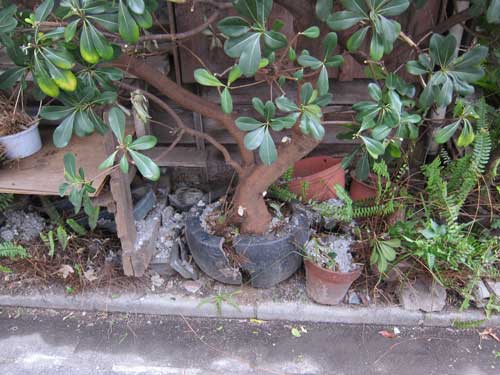

The incredibly prolific, creative, and productive Chris Berthelsen has launched a new public project, called ここの話, Koko no hanashi: Talking about Here. It’s an amazing, low tech and also analog project that creates community dialogue about public, publicly visible, and abandoned urban spaces. He’s prototyped it this week in western Tokyo, and you can read about it online and follow its progress through Twitter and a mailing list.
Talking about Here relies on a simple framework: placing a laminated sign and a simple question, like “Why can’t we use this park at night,” to invite neighbors to discuss very local spaces that are shared, visible, or under-utilized. People can respond using the QR code, or by simply writing in the notebook that is attached to the sign with a pen. Responses will be collated on a stripped down blog specific to each location.
The five initial locations are an interesting mix: a bleak park in front of a factory (run-down, official), a friendly neighborhood park which has been declared a ‘night no-go zone’ (well-kept, official), a park under an elevated freeway (run-down, secluded, official), an abandoned car in an apartment complex parking lot (illegal use), and a deserted house on a school route (run-down, private property).
The prototype just went up this week, and there are many questions: Will the signs be taken down? Will officials contact Chris to question his actions? Will neighbors use the QR code or notebooks to record their feeling and memories? Will neighbors be interested to read what other neighbors record?
I am always amazed at Chris’ imagination and ability to make things happen, with low fidelity tools and a bit of daring. We have worked together in creating the Tokyo DIY Gardening project, including the blog and collaborative mapping workshop last August at 3331 Arts Chiyoda. I believe he’s now got four projects launched in his spare time, all of which are shared freely online.
I have asked Chris if I can participate in Phase 2 of this project. I already have a few places in mind: a beautiful abandoned wood house with a garden that is minimally maintained by a neighbor, a pedestrian path that is heavily used and sitting above an old creek, my neighbors’ fruit trees. It might be interesting to ask property owners if they would like to have a sign that seeks comments about their public gardens. I wonder what the reaction will be?



In Yotsuya, the Marunouchi subway pops out of ground in central Tokyo. From the platform, there is this amazing view that includes a still functioning, although rarely used service road, an abandoned bus stop and plaza gradually returning to the wild, and a border of exuberant independent plants. There is something beautiful to glimpse this inefficient use of space and so much lush greenery in the midst of a dense city.
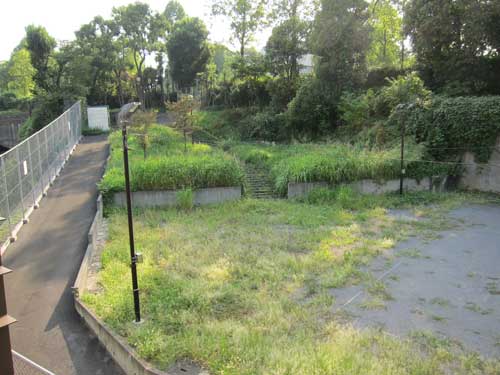
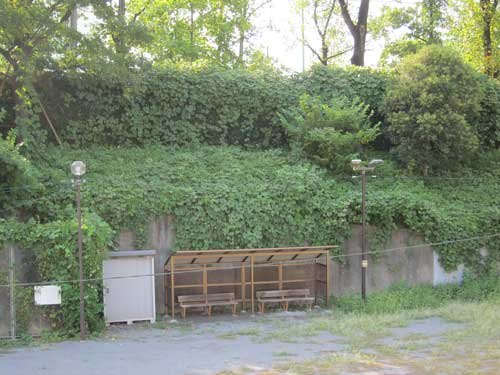
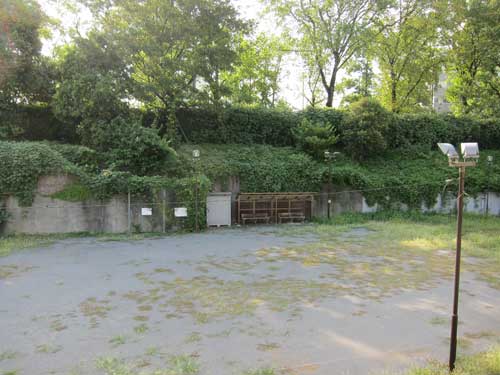

Wayward plants
A London art, plants and urbanist organization Waywardplants.org rescues unwanted plants– “discarded, abandoned, rogue, stray or runaway”— and discovers new homes where they will be cared for. This horticultural intervention has created adoption forms, placed itself in the Barbican Art Gallery in London, and encompasses a full life range from “freecycle” sharing to composting “cemetaries.”
You can watch a Wayward Plant presentation made at Pecha Kucha London. As all their talks, it is 20 slides at 20 seconds, for a total less than 7 minutes. They will also be participating in the Graham Foundation‘s exhibit, “ACTIONS: What you can do with the city” that presents 99 actions “that instigate positive change in contemporary cities around the world” based on common activities such as walking, playing, recycling, and gardening. It’s in Chicago until March 13, 2010.
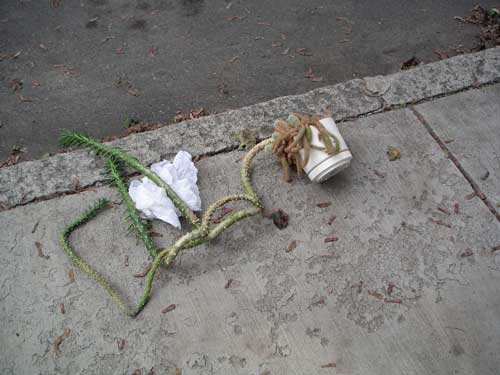

In urban settings, shrines and the entrances to cemeteries are open all day and night. Especially at night, they provide equal doses of nature and mystery that is both within and separate from normal urban life. These long exposure photos capture some of the magical beauty of nighttime trees, plants, shadows and stones.
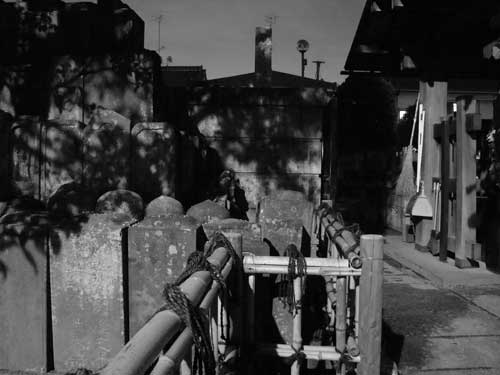
This experience in a nighttime cemetery reminds me of a term I recently learned from a Tokyo University professor who works at Hakuhodo: harappa (原っぱ). Harappa is an in-between urban and wild place that traditionally allowed children a space to play and explore. It could be a meadow, a grove of trees, or an abandoned building. With ever increasing construction and denser urban lives, these liminal spaces are harder to find. Shrines function as one of the most solid barriers against total urbanization.
A small tip: I recently learned how to take crisp nighttime photos with an inexpensive digital camera. To avoid shaking and blurring from long exposures, use the timer and set the camera on a hard surface.